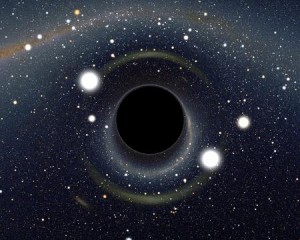
A computer-generated image of the light distortions created by a black hole. (Credit: Alain Riazuelo, IAP/UPMC/CNRS)
A cosmic flash generated by a dying star might allow scientists to see something they’ve never witnessed before – the birth of a black hole.
A black hole is a celestial object that is so dense not even light can escape its intense gravitational pull. This phenomenon occurs when a dying star runs out of fuel and collapses under the weight of its own gravity.
A dying star that produces a black hole normally does so without a bang or flash, seeming to simply disappear from the sky in an event some scientists call an “un-nova.”
“You don’t see a burst,” said Tony Piro, a postdoctoral scholar at the California Institute of Technology (Caltech). “You see a disappearance.”
Some dying stars do explode as powerful gamma-ray bursts before becoming black holes, but scientists say that’s quite rare and requires very unusual conditions.
“We don’t think most run-of-the-mill black holes are created that way,” said Piro.
But, according to his new analysis published in Astrophysical Journal Letters, a dying star might emit a cosmic flash which could alert researchers that a black hole is about to be formed.
That flash would bright enough to be seen in nearby by galaxies, according to Piro.
“That flash is going to be very bright, and it gives us the best chance for actually observing that this event occurred,” he said. “This is what you really want to look for.”
Piro says astronomers working with sky surveys should be able to observe one of these cosmic flashes about once a year.





















So maybe scientists will soon receive indications of ‘possible’ confirmation.
That could happen.